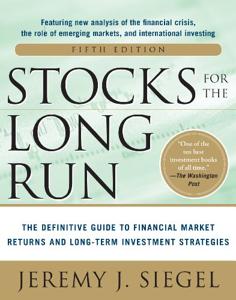
Want to learn the ideas in Stocks for the Long Run better than ever? Read the world’s #1 book summary of Stocks for the Long Run by Jeremy Siegel here.
Read a brief 1-Page Summary or watch video summaries curated by our expert team. Note: this book guide is not affiliated with or endorsed by the publisher or author, and we always encourage you to purchase and read the full book.
Video Summaries of Stocks for the Long Run
We’ve scoured the Internet for the very best videos on Stocks for the Long Run, from high-quality videos summaries to interviews or commentary by Jeremy Siegel.
1-Page Summary of Stocks for the Long Run
The Long and Short of Financial Market Performance
In the past 200 years, the US economy has evolved from an agrarian society to a global economic and political powerhouse. The nation went through some rough times, such as the Great Depression and World War II, but it also experienced growth in other areas.
Over 210 years, stocks have averaged a 6.6% annual return when adjusted for inflation while long-term government bonds returned 3.6%. In the first 150 years of this time frame, prices were relatively stable and then they started to rise in the last 60 years due to changing monetary standards from gold to paper money.
Bond prices rise and fall as interest rates move up or down. Bond prices peaked in the 1970s when interest rates were high, and they have been declining since 1981. In 1997, the US introduced inflation-adjusted bonds that tracked CPI (Consumer Price Index). The recession of 2007 to 2009 caused yields on those bonds to decline below zero by 2011.
Stocks have historically provided the best returns over time, but they undergo large swings in price. During the 1980s and 1990s, stocks increased 10 times their value due to lower inflation and interest rates. After Iraq fell during the Gulf War, there was a long bull run of stock prices that peaked at 11,722.98 on January 14, 2000. The NASDAQ reached its peak of 5132 on March 10th 2000 but soon lost much of its value as a result of the dotcom bubble bursting. From then until 2002 stocks doubled in value again from October 2002 to October 2007
But in April 2007, financial stocks were suffering from declining real estate values and problems with the subprime mortgage market. In 2008, Lehman Brothers went bankrupt and JPMorgan Chase bought Bear Stearns at a fire-sale price. The worst economic crisis since the Great Depression followed.
What Caused the 2008 Financial Crisis?
The subprime mortgage crisis and the recession that followed were caused by overleveraged real estate investments. By 2007, more than $2.8 trillion of mortgages existed in the US alone. The high ratings given to these mortgage-backed securities by major rating agencies gave investors a false sense of confidence and led them to make bad decisions based on those faulty ratings.
Investors bought complex financial products that were based on mortgages. They assumed that if the borrower defaulted, the underlying property would be worth more than what was owed. However, home prices fell 4%, which destroyed their risk models for mortgage-backed securities. Other factors contributing to the 2008 recession included regulatory failures and political pressures to expand homeownership to less-qualified buyers. The US economy then entered its second longest recession, topped only by the Great Depression of 1930s (which lasted 43 months).
Getting the Right Portfolio Mix
Portfolios are made up of different investment instruments, such as stocks and bonds. Each has a return that’s based on the level of risk an investor is willing to take. Investors can make comparisons using historical data to determine the total real returns from different combinations of assets over short- or long-term periods.
Over a long period of time, the average return for stocks is higher than other investment instruments. Therefore, if you invest in stocks over 30 years, your risk will be lower than investing in bonds or Treasury bills.
Modern portfolio theory has a concept called the “efficient frontier” that says investors can get the lowest possible risk by investing in a mix of stocks and bonds. The efficient frontier shows how different portfolios can provide varying returns with different levels of risk.





